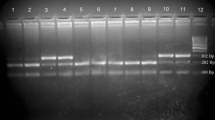Abstract
Monocyte chemoattractant protein-1 (MCP1) polymorphism has been reported to be associated with systemic lupus erythematosus (SLE). However, the correlation between the polymorphism and SLE is poorly understood. In this study we investigated the role of this polymorphism together with that of chemokine SDF1-3′A and chemokine receptor CCR2-V64I. The association between gene polymorphism and SLE was explored by way of a case-control study. In 143 patients with SLE and 157 healthy controls, the polymorphisms of SDF1-3′A, −2518MCP-1 and CCR2-V64I were determined using PCR-RFLP and an amplification-refractory mutation system, respectively. No significant difference was found in allelic and genotype frequency of SDF1-3′A, CCR2-V64I and −2518MCP-1 between SLE patients and controls. However, a significant increase in the frequency of the AG genotype of MCP-1 was found among patients with arthritis (Pc=0.003, OR 3.08, 95%CI 1.27–7.57). The frequency of individuals having G at position −2518 of the MCP-1 gene was also increased among patients with arthritis (Pc=0.028, OR 2.99, 95%CI 1.13–8.08). It is noteworthy that the frequency of −2518MCP-1G in the Chinese Han population was 64%. The results indicate an association between the presence of G at position −2518 in the MCP-1 promoter region and the presence of arthritis in patients with SLE.
Similar content being viewed by others
References
Belmont HM, Abramson SB, Lie JT (1996) Review: pathology and pathogenesis of vascular injury in systemic lupus erythematosus: interactions of inflammatory cells and activated endothelium. Arthritis Rheum 39:9–22
Koh DR, Ho A, Rahemtulla A et al (1995) Murine lupus in MRL/lpr mice lacking CD4 or CD8 T cells. Eur J Immunol 25:2558–2562
Wada T, Yokoyama H, Su SB, et al (1996) Monitoring urinary levels of monocyte chemotactic and activating factor reflects disease activity of lupus nephritis. Kidney Int 49:761–767
Kaneko H, Ogasawara H, Naito T, et al (1999) Circulating levels of beta-chemokines in systemic lupus erythematosus. J Rheumatol 26:568–573
Rovin BH, Lu L, Saxena R (1999) A novel polymorphism in the MCP-1 gene regulatory region that influences MCP-1 expression. Biochem Biophys Res Commun 259:344–348
Szalai C, Kozma GT, Nagy A, et al (2001) Polymorphism in the gene regulatory region of MCP-1 is associated with asthma susceptibility and severity. J Allergy Clin Immunol 108:375–381
Szalai C, Duba J, Prohaszka Z, et al (2001) Involvement of polymorphisms in the chemokine system in the susceptibility for coronary artery disease (CAD). Coincidence of elevated Lp(a) and MCP-1-2518 G/G genotype in CAD patients. Atherosclerosis 158:233–239
Mackay CR (1996) Chemokine receptors and T cell chemotaxis. J Exp Med 184:799–802
Boring L, Gosling J, Cleary M, et al (1998) Decreased lesion formation in CCR2−/− mice reveals a role for chemokines in the initiation of atherosclerosis. Nature 394:894–897
Kennedy KJ, Strieter RM, Kunkel SL, et al (1998) Acute and relapsing experimental autoimmune encephalomyelitis are regulated by differential expression of the CC chemokines macrophage inflammatory protein-1 alpha and monocyte chemotactic protein-1. J Neuroimmunol 92:98–108
Ransohoff RM (1999) Mechanisms of inflammation in MS tissue: adhesion molecules and chemokines. J Neuroimmunol 98:57–68
Michael NL, Louie LG, Rohrbaugh AL, et al (1997) The role of CCR5 and CCR2 polymorphisms in HIV-1 transmission and disease progression. Nat Med 3:1160–1162
Lee B, Doranz BJ, Rana S, et al (1998) Influence of the CCR2-V64I polymorphism on human immundeficiency virus type 1 coreceptor activity and on chemokine receptor function of CCR2b, CCR3, CCR5, and CXCR4. J Virol 72:7450–7458
Tashiro K, Tada H, Heilker R, et al (1993) Signal sequence trap: a cloning strategy for secreted proteins and type I membrane proteins. Science 261:600–603
Nagasawa T, Kikutani H, Kishimoto T (1994) Molecular cloning and structure of a pre-B-cell growth-stimulating factor. Proc Natl Acad Sci U S A 91:2305–2309
D’Apuzzo, M, Rplink A, Loetscher M, et al (1997) The chemokine SDF-1, stromal cell-derived factor 1, attracts early stage B cell precursors via the chemokine receptor CXCR4. Eur J Immunol 27:1788–1793
Bleul CC, Fuhlbrigge RC, Casasnovas JM, et al (1996) A highly efficacious lymphocyte chemoattractant, stromal cell-derived factor 1 (SDF-1). J Exp Med 184:1101–1109
Nagasawa T, Hirota S, Tachibana K, et al (1996) Defects of B-cell lymphopoiesis and bone-marrow myelopoiesis in mice lacking the CXC chemokine PBSF/SDF-1. Nature 382:635–638
Nanki T, Lipsky PE (2000) Cutting edge: stromal cell-derived factor-1 is a costimulator for CD4+ T cell activation. J Immunol 164:5010–5014
Nanki T, Hayashida K, El-Gabalawy HS, et al (2000) Stromal cell-derived factor-1-CXC chemokine receptor 4 interactions play a central role in CD4+ T cell accumulation in rheumatoid arthritis synovium. J Immunol 165:6590–6598
Winkler C, Modi W, Smith MW, et al (1998) Genetic restriction of AIDS pathogenesis by an SDF-1 chemokine gene variant. Science 279:389–393
Easterbrook PJ, Rostron T, Ives N, et al (1999) Chemokine receptor polymorphisms and human immunodeficiency virus disease progression. J Infect Dis 180:1096–1105
Noris M, Bernasconi S, Casiraghi F, et al (1995) Monocyte chemoattractant protein-1 is excreted in excessive amounts in the urine of patients with lupus nephritis. Lab Invest 73:804–809
Rovin BH, Rumancik M, Tan L, et al (1994) Glomerular expression of monocyte chemoattractant protein-1 in experimental and human glomerulonephritis. Lab Invest 71:536–542
Harigai M, Hara M, Yashimura T, et al (1993) Monocyte chemoattractant protein-1(MCP-1) in inflammatory joint diseases and its involvement in the cytokine network of rheumatoid synovium. Clin Immunol Immunopathol 69:83–91
Asano T, Ogawa S (2000) Expression of monocyte chemoattractant protein-1 in Kawasaki disease: the anti-inflammatory effect of gamma globulin therapy. Scand J Immunol 51:98–103
Tesch GH, Maifert S, Schwarting A, et al (1999) Monocyte chemoattractant protein 1-dependent leukocytic infiltrates are responsible for autoimmune disease in MRL-Faslpr mice. J Exp Med 190:1813–1824
Zoja C, Liu XH, Donadelli R, et al (1997) Renal expression of monocyte chemoattractant protein-1 in lupus autoimmune mice. J Am Soc Nephrol 8:720–729
Hwang SY, Cho ML, Park B, et al (2002) Allelic frequency of the MCP-1 promoter −2518 polymorphism in the Korean population and in Korean patients with rheumatoid arthritis, systemic lupus erythematosus and adult-onset Still’s disease. Eur J Immunogenet 29:413–416
Aguilar F, Gonzalez-Escribano MF, Sanchez-Roman J, et al (2001) MCP-1 promoter polymorphism in Spanish patients with systemic lupus erythematosus. Tissue Antigens 58:335–338
Kim HL, Lee DS, Yang SH, et al (2002) The polymorphism of monocyte chemoattractant protein-1 is associated with the renal disease of SLE. Am J Kidney Dis 40:1146–1152
Dongqing YE (2001) Dermato-epidemiology. People Healthy Press, Beijing, pp 480–487
Firestein GS, Yeo M, Zvaifler NJ (1995) Apoptosis in rheumatoid arthritis synovium. J Clin Invest 96:1631–1638
Acknowledgements
We thank the patients for their cooperation in donating blood samples. This work was funded by grants from the National Natural Science Foundation of China (30371247), the Natural Science Foundation of Anhui Province (98437231) and the Key Program of Anhui Province Education Department (2002 kj175ZD). This article was prepared with the assistance of Dr. Maxia Dong from the Division of Adult and Community Health, National Center for Disease Control and Prevention, USA.
Author information
Authors and Affiliations
Corresponding author
Rights and permissions
About this article
Cite this article
Ye, D.Q., Hu, Y.S., Li, X.P. et al. The correlation between monocyte chemoattractant protein-1 and the arthritis of systemic lupus erythematosus among Chinese. Arch Dermatol Res 296, 366–371 (2005). https://doi.org/10.1007/s00403-004-0531-y
Received:
Revised:
Accepted:
Published:
Issue Date:
DOI: https://doi.org/10.1007/s00403-004-0531-y




